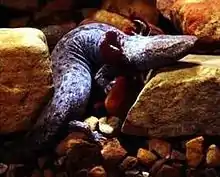Necturus
Necturus is a genus of aquatic salamanders native to the eastern United States and Canada.[1][2][3] They are commonly known as waterdogs and mudpuppies.[1][2] The common mudpuppy (N. maculosus) is probably the best-known species – as an amphibian with gill slits, it is often dissected in comparative anatomy classes.
| Necturus | |
|---|---|
 | |
| Necturus maculosus maculosus | |
| Scientific classification | |
| Kingdom: | Animalia |
| Phylum: | Chordata |
| Class: | Amphibia |
| Order: | Urodela |
| Family: | Proteidae |
| Genus: | Necturus Rafinesque, 1819 |
| Species | |
|
7 species ( but see text) | |
| Synonyms[1] | |
| |
Taxonomy
The genus is under scrutiny by herpetologists.[1] The relationship between the species is still being studied. In 1991 Collins elevated N. maculosus louisianensis to full species status, usually considered a subspecies of the common mudpuppy (N. maculosus), but his interpretation was not followed.[1][4][5]
Species
There are five species:[4]
- Necturus alabamensis Viosca, 1937 – Alabama waterdog
- Necturus beyeri Viosca, 1937 – Gulf Coast waterdog
- Necturus lewisi Brimley, 1924 – Neuse River waterdog
- Necturus maculosus (Rafinesque, 1818) – Common mudpuppy
- Necturus maculosus louisianensis Viosca, 1938 syn. N. lodingi Viosca, 1937 – Red River mudpuppy, Mobile mudpuppy. These two names have been recognised as independent species in the past.[2]
- Necturus punctatus (Gibbes, 1850) – dwarf waterdog
Two known fossil species, N. krausei and an unnamed species, are respectively known from the Paleocene of Saskatchewan and from Florida during the Pleistocene.[6][7]
Description
Necturus are paedomorphic: adults retain larval-like morphology with external gills, two pairs of gill slits, and no eyelids. They are moderately robust and have two pairs of short but well-developed limbs and a large, laterally compressed tail. Lungs are present but small. Typical adult size is 20–25 cm (8–10 in) in total length, but Necturus punctatus is larger and may reach 40 cm (16 in).[3]
Ecology
Necturus occur in surface waters, preferentially with clear water and rocky substrates without silt. They forage during the night and eat a variety of prey, but have preference for crayfish.[3]
References
- Frost, Darrel R. (2019). "Necturus Rafinesque, 1819". Amphibian Species of the World: an Online Reference. Version 6.0. American Museum of Natural History. Retrieved 9 June 2019.
- "North American Herpetofauna: Amphibia: Caudata". Centre for North American Herpetology. Retrieved 9 June 2019.
- Vitt, Laurie J. & Caldwell, Janalee P. (2014). Herpetology: An Introductory Biology of Amphibians and Reptiles (4th ed.). Academic Press. pp. 463–465.
- "Proteidae". AmphibiaWeb. University of California, Berkeley. 2019. Retrieved 9 June 2019.
- Petranka, J.W. (1998). Salamanders of the United States and Canada. Smithsonian Institution Press ISBN 1588343081.
- "Fossilworks: Necturus krausei". fossilworks.org. Retrieved 2018-12-24.
- "PBDB". Necturus Rafinesque (mudpuppy).
External links
 Media related to Necturus at Wikimedia Commons
Media related to Necturus at Wikimedia Commons